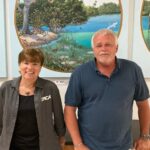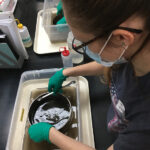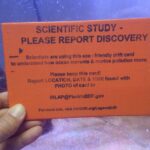INDIAN RIVER COUNTY — If pollution could be made visible, we would be able to see where it was entering the water ways, and how it was accumulating in the ecosystem. To address this challenge, the Ocean Research & Conservation Association (ORCA) has developed technology designed to identify pollution sources and sinks and then provide this information as easily interpretable pollution gradient maps. The end result is information needed to enforce the Clean Water Act and provide feedback to policy makers and the public on whether goals are being met and tax dollars effectively spent.
The first step is to locate sinks – places where pollution accumulates in the sediments of a given water body. Sediments have a natural affinity for pollutants and contaminants often have a much longer residence time in sediments than in water, so the best indicator of local water pollution problems often lies on the bottom.
Collecting sediment samples is easy. Analyzing them in an efficient and cost effective manner is not. There are so many potential pollutants – including heavy metals, PCBs and other industrial pollutants, and an ever growing array of pesticides and herbicides – that a comprehensive analysis of a single sedi ment sample can take weeks to months and cost thousands of dollars.
ORCA has solved this challenge with its Fast Assessment of Sediment Toxicity or FAST program, which uses a broad spectrum bio-assay that is the equivalent of a canary in a coal mine. With FAST the amount of light emitted by a known concentration of bioluminescent bacteria exposed to the sample is inversely related to the toxicity of the sample. When toxicity levels are mapped, a visual representation of high toxicity values cluster together at the location where the contaminated sediments accumulate.
The next step is to determine the water flow patterns that created them. ORCA has developed the ORCA KilroyTM proprietary network, a wireless array of low-cost sensors that supply real-time data via the Internet. KilroyTM networks are instrumented with low-cost, state-of-the-art sensors that continuously measure an array of water quality parameters – flow speed, direction, temperature, depth, turbidity and the prevalence of key microorganisms (including those responsible for red tides that produce paralytic shellfish poison); streaming real time data to the ORCA database 24 hours a day.
Data is then overlaid on Google based maps where it can be accessed by interested parties. When utilized in groups the KilroyTM units create networks that are ideally suited to monitoring large, complex marine ecosystems. By combining FAST data with Kilroy data in computational modeling, the water flow patterns, water quality, sediment erosion, and sediment accumulation patterns make it possible to time-step, advancing backwards in time, to reveal the sources of contaminants.
These models also provide the means for adaptive management; loosely defined as “learning by doing.” They are widely recognized as our best weapon to recreate past events and predict future patterns that could have a detrimental impact on our ecosystems.
ORCA is a 501(c)(3) nonprofit corporation dedicated to the protection and restoration of aquatic ecosystems and the species they sustain through the development of innovative technologies and science based conservation action.
Team ORCA will provide its members with unique opportunities to learn about environmental concerns that may have an impact on their lives here on the Treasure Coast. A donation of $50 or more will qualify you to become a member of Team ORCA.
New members will receive a Team ORCA T-shirt and car decal, and will have opportunities for events and outings, such as a bioluminescence kayaking trip with Dr. Widder, local environmental boat cruises with an ORCA scientist, Team ORCA cookouts & outings, VIP lectures and tours; and members-only invitations to other special events.
For more information on how to become a Team ORCA member, call 772-467-1600 or visit www.teamorca.org.






